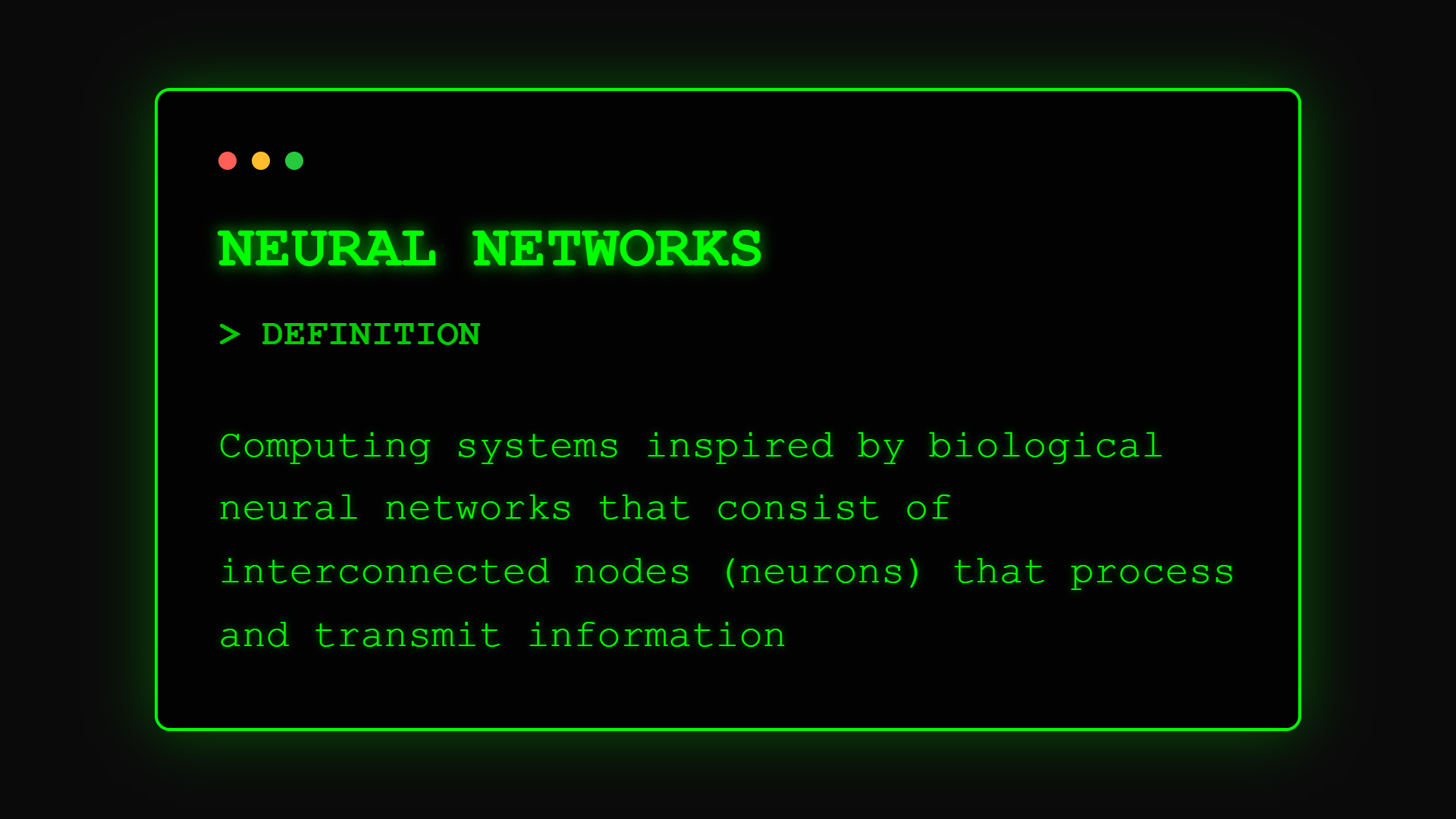AI Terms
What is a Neural Network? Building AI That Thinks Like a Brain

Your brain processes information through 86 billion interconnected neurons, enabling you to recognize faces instantly, understand language, and make complex decisions. Neural networks bring this same principle to machines, creating AI systems that learn and adapt just like biological brains but with the speed and scale of computers.
Foundation and Technical Background
Neural networks trace back to 1943 when neurophysiologist Warren McCulloch and mathematician Walter Pitts created the first mathematical model of biological neurons. They proposed that simplified artificial neurons could compute any logical function.
The formal definition from the Institute of Electrical and Electronics Engineers (IEEE) describes neural networks as "computing systems inspired by biological neural networks, consisting of interconnected groups of artificial neurons that process information using a connectionist approach to computation."
The field experienced several "AI winters" when progress stalled, but breakthroughs in training algorithms (backpropagation in 1986) and computing power (GPUs in 2009) finally unlocked their potential, leading to today's AI revolution.
Business Understanding
For business leaders, neural networks are the fundamental building blocks of AI: systems of interconnected processors that learn patterns from data, enabling machines to make intelligent decisions without explicit programming.
Think of a neural network as a highly efficient learning machine. Just as your brain strengthens connections between neurons when learning (like recognizing a friend's voice), artificial neural networks adjust their connections to recognize patterns in business data.
In practical terms, neural networks power the AI behind fraud detection, customer service chatbots, demand forecasting, and countless other business applications where traditional programming falls short.
Five Essential Elements
Neural networks consist of these essential elements:
• Neurons (Nodes): Basic processing units that receive inputs, apply mathematical functions, and produce outputs, like simplified brain cells
• Connections (Weights): Links between neurons with adjustable strengths that determine how much influence one neuron has on another
• Layers: Organized groups of neurons where input layer receives data, hidden layers process it, output layer delivers results
• Activation Functions: Mathematical gates that determine when neurons "fire," introducing non-linearity essential for learning complex patterns
• Learning Algorithm: The method for adjusting weights based on errors, typically backpropagation, which fine-tunes the network through experience
The Neural Network Process
The neural network process follows these steps:
Input Processing: Data enters through the input layer. For credit scoring, this might be income, credit history, and debt ratios converted to numbers
Signal Propagation: Each neuron multiplies inputs by weights, sums them, and applies an activation function, passing results to the next layer, creating increasingly abstract representations
Output Generation: The final layer produces predictions. In our credit example, a probability of loan repayment based on patterns learned from thousands of previous loans
The network learns by comparing predictions to actual outcomes and adjusting weights to minimize errors, gradually becoming more accurate.
Network Architectures
Neural networks generally fall into four main architectures:
Type 1: Feedforward Networks Best for: Classification, regression, pattern recognition Key feature: Information flows in one direction only Example: Email spam filters, basic fraud detection
Type 2: Convolutional Networks (CNNs) Best for: Image recognition, video analysis Key feature: Specialized for processing grid-like data Example: Quality control systems detecting product defects
Type 3: Recurrent Networks (RNNs) Best for: Sequential data, time series, language Key feature: Memory of previous inputs Example: Stock price prediction, voice assistants
Type 4: Autoencoder Networks Best for: Data compression, anomaly detection Key feature: Learns efficient data representations Example: Detecting unusual patterns in cybersecurity
Neural Networks in Business
Here's how businesses actually use neural networks:
Banking Example: Capital One uses neural networks to detect credit card fraud in real-time, analyzing hundreds of variables per transaction to identify suspicious patterns with 95% accuracy.
E-commerce Example: Pinterest's neural network-based visual search analyzes billions of images, allowing users to find products by uploading photos, increasing engagement by 40%.
Manufacturing Example: Siemens uses neural networks for predictive maintenance, analyzing sensor data to predict equipment failures 36 hours in advance with 92% accuracy.
Continue Learning
Ready to understand neural networks' role in your AI strategy?
- Start with Artificial Intelligence fundamentals
- Explore how networks enable Deep Learning
- See practical applications in Machine Learning
- Learn implementation with our Neural Network Business Guide
FAQ Section
Frequently Asked Questions about Neural Networks
Part of the [AI Terms Collection]. Last updated: 2025-01-10